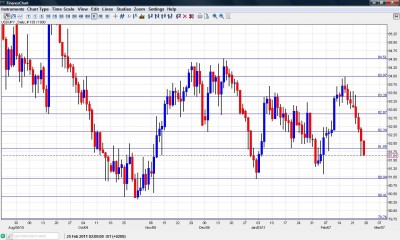Preliminary Industrial Production and Retail Sales are among the numerous events are scheduled this week. Here is an outlook on the major events and an updated technical analysis for USD/JPY.
Bank of Japan Deputy Governor Hirohide Yamaguchi claims Japanese economy will soon regain pace and tackle deflation despite the stagnated situation in January. Improvement in exports make an upward trend giving room for optimism.
USD/JPY daily chart with support and resistance lines marked. Click to enlarge:
-
Manufacturing PMI: Sunday, 23.15. Japanese manufacturing activity expanded for the first time in five months in January rising to a seasonally adjusted 51.4 in January from 48.3 in December. This climb shows improvement in the market and raised optimism regarding the 2011 outlook for the wider economy.
-
Prelim Industrial Production: Sunday, 23.50. The nation’s Industrial Production rose by 3.1% in December 2010 following a 5.8% increase in November indicating growth in Industrial Output. Over the year to December 2010, the Industrial Production rose by 4.6%. A further rise of 4.1% is expected now.
-
Retail Sales: Sunday, 23.50. Retail sales in Japan dropped 2.0% in December following an increase of 1.5% in November. Analysts expected an increase of 0.6 percent. A smaller drop of 1.5% is predicted this time.
-
Housing Starts: Monday, 5:00. Japanese housing starts rose 7.5 % in December from a year earlier thanks to government stimulus measures and tax breaks for energy-efficient homes. The rise was above expectations of a 4.6 % annual gain and followed a 6.8 percent rise in November. It marked the seventh straight month of annual rises. A gain of 5.6% is forecasted now.
-
Household Spending: Monday, 23:30. Average household spending in Japan fell 3.3% in December. Average spending stood at 327,006 yen (3,945 U.S. dollars) in December, which was sharply below analysts’ expectations for a decline of 0.6 percent on year following the 0.4 percent annual drop in November. Another drop of 1.3% is predicted.
-
Average Cash Earnings: Tuesday, 1:30. Average monthly wages in Japan increased by 0.5 % to average 317,092 yen (3,865 U.S. dollars) in 2010 for the first time in four years, indicating a gradual recovery in the labor market. In addition, the labor ministry reported that overtime hours worked, which significantly drives up cash earnings, rose 8.9 percent in 2010, marking the first rise in three years. Average monthly wages is expected a 0.3% gain.
-
Monetary Base: Tuesday, 23:50. Japan’s monetary base rose 5.5 % in January from a year earlier. This is 29th straight month of increase. The balance of BOJ notes in circulation increased 2.0 percent to 79.41 trillion yen. A bigger rise of 6.4% is expected now.
-
Capital Spending: Wednesday, 23:50. Japanese corporate capital spending registered the first increase in three and a half years in the July-September period, rising 5.0% while analysts expected 6.1% rise. This followed a decrease of 1.7% in the previous quarter. A higher rise of 5.9% is predicted.
*All times are GMT
USD/JPY Technical Analysis
The dollar had a disastrous week against the yen. USD/JPY dropped gradually. After losing 82.87 (mentioned last week), a recovery attempt met resistance at this line and the fall continued, with the close at 81.64.
Looking up, immediate resistance is now found at 81.80, a line which previously worked as support, and now serves as week resistance. It’s followed by 82.34, which was a swing low a few months ago, and worked as support just now.
Further above, 82.87 is the next cap – it was the point were the BOJ intervened back in September 2010. Higher, 83.40 provides immediate resistance, though weaker than in previous weeks.
Higher we find 84, which was quite stubborn two weeks ago, is a tough line of resistance. Above, the next line above is 84.50 which is the highest level since October and is a very tough resistance line. Above, 85.93 was the top that the pair made after the BOJ intervention in September.
Looking down, we find strong support at 80.87 – which provided support back in November and now has the same role. Further below, 80.40, was the lowest close ever and by 79.75, the lowest intra-day level, reached back in 1995. Not much left down there.
I am neutral on USD/JPY.
The magnitude of Middle -Eastern events has been extraordinary. This sent oil up and the dollar down, with the yen being one of the big winners. When the Libyan crisis ends, dollar/yen will rise back up, but the level of uncertainty is very high.
Further reading:
-
For a broad view of all the week’s major events worldwide, read the USD outlook.
-
For EUR/USD, check out the Euro/Dollar forecast.
-
For GBP/USD (cable), look into the British Pound forecast.
-
For the Australian dollar (Aussie), check out the AUD to USD forecast.
-
For the New Zealand dollar (kiwi), read the NZD forecast.
-
For USD/CAD (loonie), check out the Canadian dollar.
